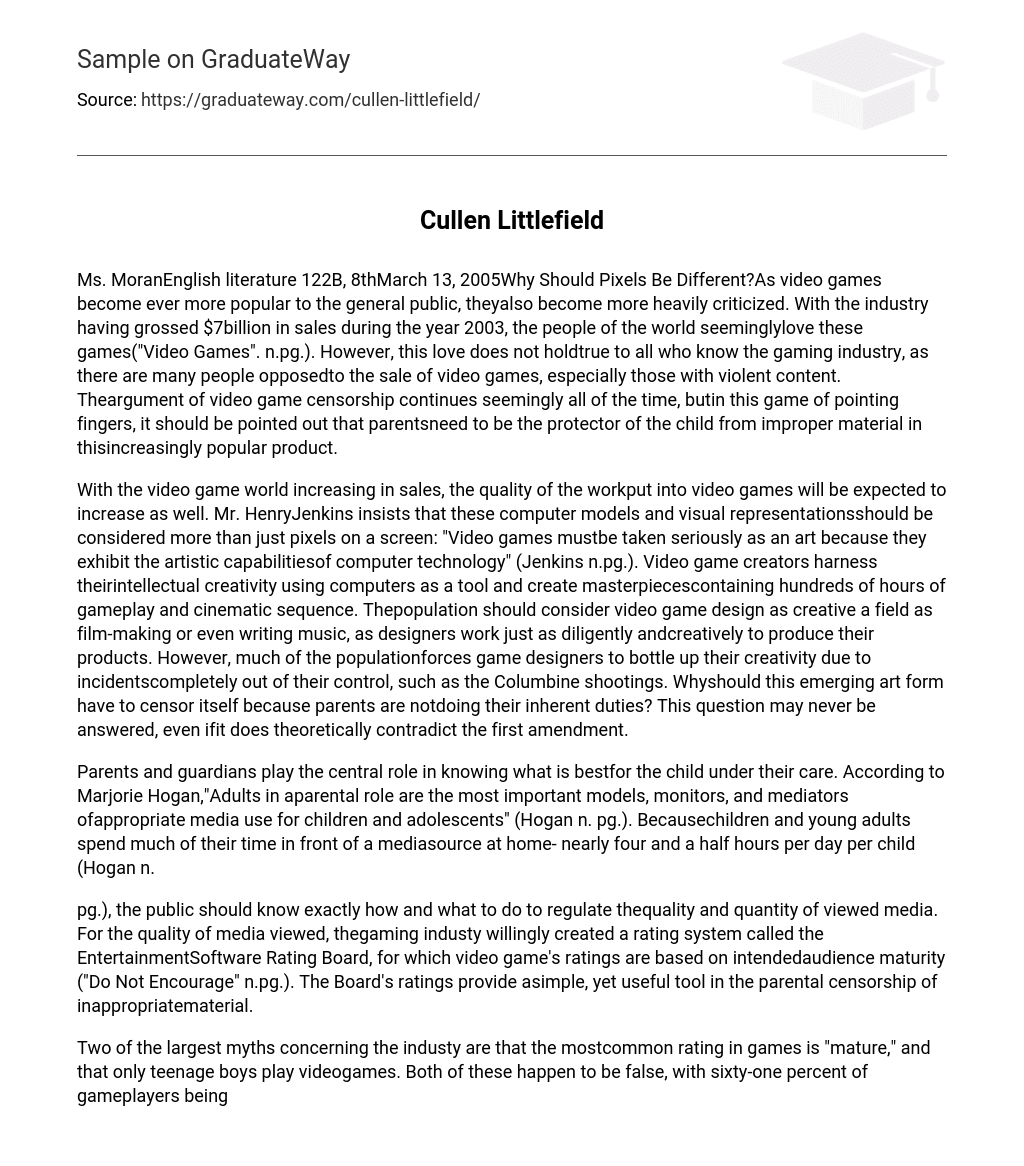Why Should Pixels Be Different?As video games become ever more popular to the general public, theyalso become more heavily criticized. With the industry having grossed $7billion in sales during the year 2003, the people of the world seeminglylove these games(“Video Games”. n.pg.). However, this love does not holdtrue to all who know the gaming industry, as there are many people opposedto the sale of video games, especially those with violent content. Theargument of video game censorship continues seemingly all of the time, butin this game of pointing fingers, it should be pointed out that parentsneed to be the protector of the child from improper material in thisincreasingly popular product.
With the video game world increasing in sales, the quality of the workput into video games will be expected to increase as well. Mr. HenryJenkins insists that these computer models and visual representationsshould be considered more than just pixels on a screen: “Video games mustbe taken seriously as an art because they exhibit the artistic capabilitiesof computer technology” (Jenkins n.pg.). Video game creators harness theirintellectual creativity using computers as a tool and create masterpiecescontaining hundreds of hours of gameplay and cinematic sequence.
Thepopulation should consider video game design as creative a field as film-making or even writing music, as designers work just as diligently andcreatively to produce their products. However, much of the populationforces game designers to bottle up their creativity due to incidentscompletely out of their control, such as the Columbine shootings. Whyshould this emerging art form have to censor itself because parents are notdoing their inherent duties? This question may never be answered, even ifit does theoretically contradict the first amendment.
Parents and guardians play the central role in knowing what is bestfor the child under their care. According to Marjorie Hogan,”Adults in aparental role are the most important models, monitors, and mediators ofappropriate media use for children and adolescents” (Hogan n. pg.). Becausechildren and young adults spend much of their time in front of a mediasource at home- nearly four and a half hours per day per child (Hogan n. pg.), the public should know exactly how and what to do to regulate thequality and quantity of viewed media. For the quality of media viewed, thegaming industy willingly created a rating system called the EntertainmentSoftware Rating Board, for which video game’s ratings are based on intendedaudience maturity (“Do Not Encourage” n.pg.).
The Board’s ratings provide asimple, yet useful tool in the parental censorship of inappropriatematerial. Two of the largest myths concerning the industy are that the mostcommon rating in games is “mature,” and that only teenage boys play videogames. Both of these happen to be false, with sixty-one percent of gameplayers being over the age of eighteen and only nine percent of games beingrated “mature” (“Regulates Itself” n.pg.).
Parents are encouraged tosupervise their child while he or she is interacting with the media source;viewing with the child helps to inform the parent exactly what the child iswatching or playing, and it helps the child understand mechanics, as wellas plot lines of the viewed media. According to B.A. Eisenstock, co-viewingwith a sibling, parent, or peer “creates an opportunity to mediatechildren’s understanding and interpretation of the reality and morality ofmessages” (Hogan n.pg.). The opportunity created by viewing with a child isa learning experience for both guardian and child.
As the Entertainment Software Rating Board, commonly called the ESRB,is already in place to rate the video games produced, there is no need forfurther censorship. Stores that sell video games enforce the ESRB ratingsby refusing to sell games with a “mature” rating to underage children. Ifparents maintain their responsibility, there exists no need to furthercensor video games. Enforcing the ESRB ratings creates enough of a censor;further censorship simply encroaches on the first amendment right.
Theammendment gives freedom of speech; video game design is simply a creativeform of speech and expression. Video game creators enjoy the ability topresent their ideas to the public through their medium; they do not need athird party infringing on their ideas using censorship. With the ESRBworking effectively, no extra external censorship is needed to produceappropriate video games.
Censorship is defined as deleting parts of publications, orcorrespondence, or theatrical performances. The general public seems to begoing through the same motions it had went through in the seventies withcomic books, or even now with music and movies. The free speech amendmentstates that people have the right to speak their mind, and if someone elsedoesn’t like what he or she is hearing, that person has the right not tolisten. So how is it different for video games? There is no need forcensoring this medium of expression and artwork if the tools already inplace are executed in the manner intended. If a game’s intended audience isfor adults, the parent or guardian should make sure that the game does notend up in the hands of his or her child. Many times the parent will buy thegame for the child, then turn around and blame the industry for the game.
If the public were informed, this would not happen. Since stores alreadymake sure not to sell mature rated games to children, it is the guardian’sduty to continue this precaution. It is not the government’s place.
Reference
- Hogan, Marjorie. “Parents Should Monitor Their Children’s Media Habits”Opposing Viewpoints. Gale Group. 9 Feb. 2005.
- Jenkins, Henry. “Video Games Are an Emerging Art.” Opposing Viewpoints. Gale Group 9. Feb. 2005. .
- Lowenstein, Douglas. “The Video Game Industry Regulates ItselfEffectively.” Opposing Viewpoints. Gale Group 7 Feb. 2005.
- Lowenstein, Douglas. “Violent Video Games Do Not Encourage ViolentBehavior.” Opposing Viewpoints. Gale Group. 7 Feb. 2005.
- “Video Games and Violence.” Facts.com. 13 February 2004. Issues andControversies. 13 Feb. 2005. .





